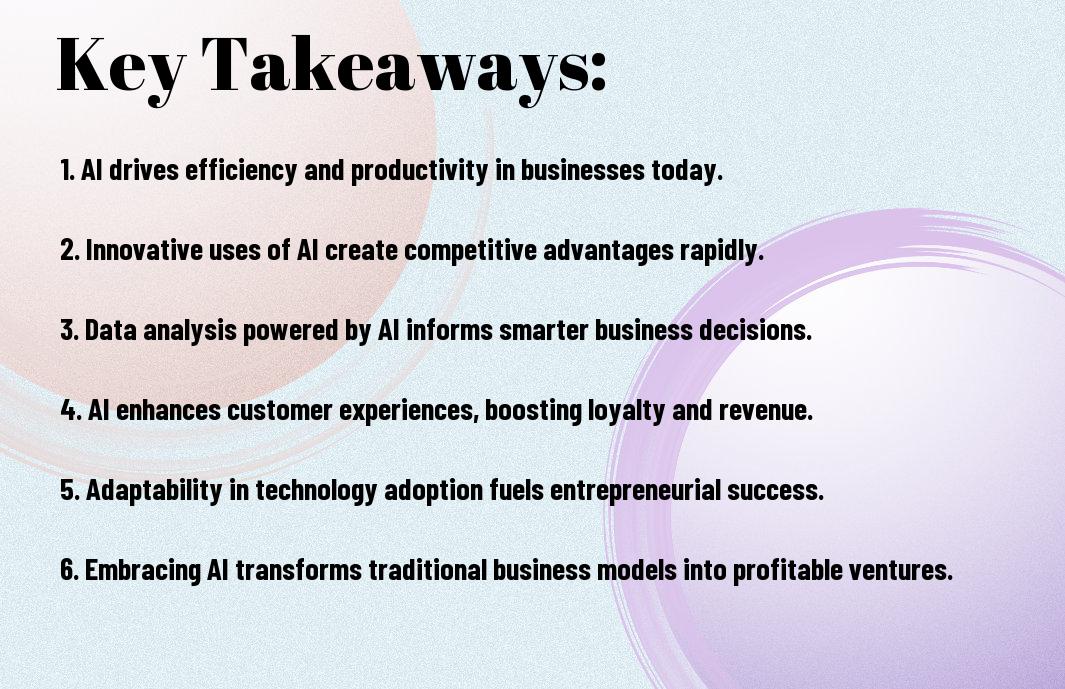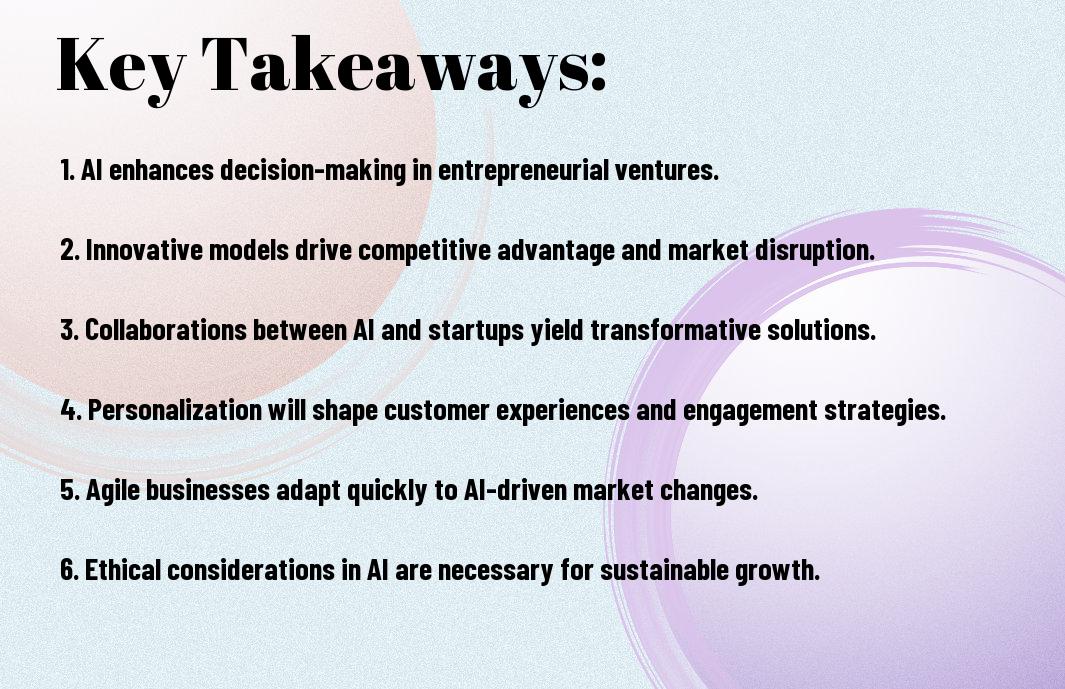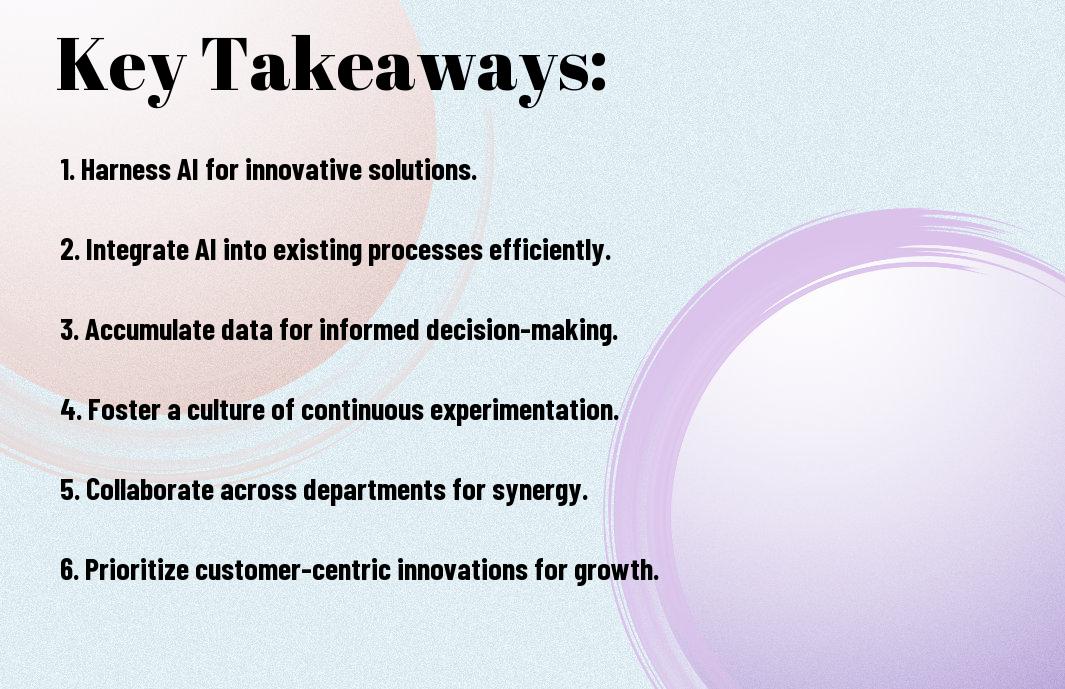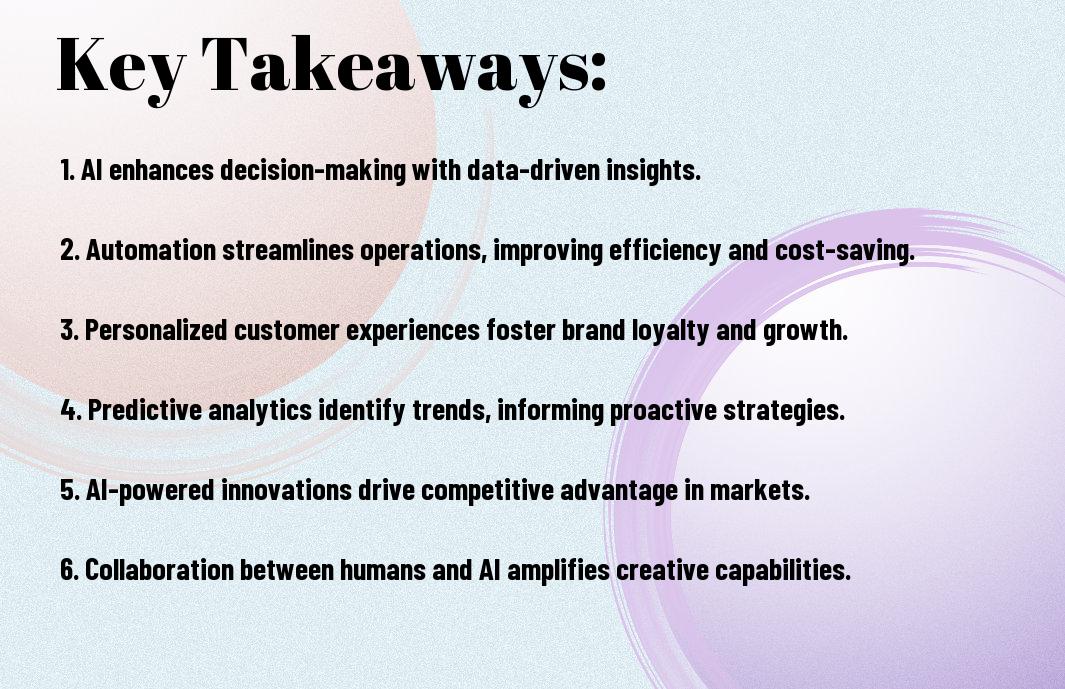As you navigate the rapidly evolving landscape of artificial intelligence, you’re likely aware of its potential to transform your business and create new wealth opportunities. You’re probably looking for ways to harness AI’s power to drive innovation and stay ahead of the competition. Your ability to leverage AI will be key to unlocking new revenue streams and achieving long-term success. By embracing AI-driven innovation, you can position yourself for significant financial gains and establish a strong foundation for your future prosperity.

Key Takeaways:
- Effective integration of AI into business models can significantly enhance innovation, leading to increased efficiency and new revenue streams, which are crucial for sustained wealth creation in today’s competitive market.
- Developing a strategic approach to AI adoption involves understanding its potential applications, assessing organizational readiness, and investing in the necessary talent and technology to drive AI-driven innovation.
- Continuous learning and adaptation are vital for organizations aiming to master AI-driven innovation, as the field of AI is rapidly evolving, and staying ahead of the curve can provide a significant competitive advantage in terms of innovation and wealth creation.
Foundations of AI-Driven Innovation
The ability to harness AI-driven innovation is key to unlocking new revenue streams and staying ahead of the competition. You will need to understand the underlying principles of AI and how they can be applied to your business to drive growth and profitability.
Core Technologies and Their Business Impact
AI-driven technologies such as machine learning and natural language processing are transforming the way you do business, enabling you to automate processes, gain insights from data, and make informed decisions that drive your business forward.
Market Opportunities in AI Landscape
Their potential to disrupt industries and create new opportunities is vast, and you can capitalize on this by identifying areas where AI can add value to your business, such as improving customer experience or optimizing operations.
Due to the rapid evolution of AI technologies, you will have numerous opportunities to innovate and differentiate your business, from developing new products and services to creating entirely new business models that leverage the power of AI, enabling you to stay competitive and achieve your goals in a rapidly changing market landscape.

Strategic Framework for AI Implementation
It is important to develop a comprehensive strategy for AI implementation, allowing you to leverage AI-driven innovation and maximize your returns on investment. You will need to consider various factors, including your organization’s goals, existing infrastructure, and potential challenges.
Resource Assessment and Planning
About the resources you have available, you should conduct a thorough assessment to determine what you need to implement AI effectively, and plan accordingly to ensure a smooth integration with your existing systems and processes, enabling you to make the most of your investment.
Risk Management and Governance
Along with the benefits of AI, you should also consider the potential risks and challenges associated with its implementation, and establish a robust governance framework to mitigate them, ensuring that your AI systems are aligned with your organization’s values and objectives.
Due to the complexity and potential impact of AI on your organization, you will need to establish clear guidelines and protocols for its development, deployment, and monitoring, allowing you to address potential issues promptly and maintain control over your AI systems, and ensuring that you can trust the decisions made by your AI-driven systems, and that they are fair, transparent, and accountable, which is vital for maintaining your organization’s reputation and building trust with your stakeholders.
Value Creation Through AI
To unlock the full potential of AI-driven innovation, you can explore strategies for wealth creation, as discussed in The Greatest Wealth Transfer in History: How AI, Passive Income and Strategic Investments Will Define the Future, to maximize your returns.
Revenue Generation Models
Above all, you should focus on developing revenue generation models that leverage AI to drive business growth, increasing your earnings and expanding your customer base.
Cost Optimization Strategies
After implementing AI-driven solutions, you can identify areas where costs can be optimized, streamlining your operations and improving efficiency, which will have a positive impact on your bottom line.
Plus, by adopting cost optimization strategies, you will be able to allocate your resources more effectively, investing in areas that drive growth and innovation, and reducing waste, allowing you to stay competitive in a rapidly changing market, and ultimately, increasing your wealth creation potential.
Innovation Pipeline Development
After establishing your AI-driven innovation strategy, you can focus on developing your innovation pipeline, which involves generating and evaluating ideas, and turning them into viable products or services that meet your customers’ needs and create new revenue streams for your business.
Research and Development Integration
Besides having a clear innovation strategy, you need to integrate your research and development efforts to ensure that your innovation pipeline is constantly filled with new and innovative ideas that can be developed into products or services.
Product Development Cycles
Integrating AI into your product development cycles enables you to accelerate the development process, reduce costs, and improve product quality, allowing you to get your products to market faster and stay ahead of the competition.
To further optimize your product development cycles, you will need to leverage AI tools and techniques, such as machine learning and predictive analytics, to analyze customer data, identify market trends, and predict product performance, enabling you to make data-driven decisions and create products that meet your customers’ evolving needs and preferences.
Competitive Advantage Building
Many organizations strive to create a competitive advantage through AI-driven innovation, and you can achieve this by leveraging cutting-edge technologies to enhance your business operations and customer experiences.
Market Positioning
Advantageously, you can position your company for success by identifying emerging trends and capitalizing on new opportunities, allowing you to stay ahead of the competition and establish a strong market presence.
Sustainable Growth Patterns
Beneath the surface of AI-driven innovation lies a complex web of factors that contribute to sustainable growth, and you must navigate these factors to achieve long-term success, considering your unique business needs and goals.
Due to the ever-evolving nature of AI and technological advancements, you will need to continuously adapt and refine your strategies to maintain a competitive edge, ensuring that your business remains agile and responsive to changing market conditions, and that your growth patterns are sustainable and aligned with your overall vision.
Scaling AI Operations
All organizations aiming to master AI-driven innovation must focus on scaling their AI operations to achieve maximum impact. You need to assess your current infrastructure, team, and processes to identify areas for improvement and develop a strategy for growth.
Infrastructure Requirements
Besides having the right technology, you must ensure your infrastructure can support the demands of AI systems, including data storage, processing power, and security. You should invest in scalable infrastructure to accommodate growing AI workloads and ensure seamless integration with existing systems.
Team Development and Culture
The key to successful AI adoption lies in developing a skilled team and fostering a culture that embraces innovation. You should focus on building a diverse team with expertise in AI, data science, and domain knowledge to drive AI-driven innovation in your organization.
In addition, as you develop your team, you will need to create an environment that encourages experimentation, learning, and collaboration, allowing your team to explore new AI applications and integrate them into your business strategy, and you will see your organization thrive in the AI-driven landscape, with your team driving growth and innovation, and you will be able to make informed decisions about AI adoption and implementation, ultimately leading to increased efficiency and revenue for your business.
Conclusion
With these considerations, you can now harness the power of AI-driven innovation to propel your business forward. You will be able to develop strategies that drive wealth creation, leveraging AI to enhance your operations and decision-making. By embracing AI, you will unlock new opportunities, stay ahead of the competition, and achieve your goals, ultimately transforming your organization and securing your place in the future. Your ability to adapt and innovate with AI will be the key to your success.
FAQ
Q: What is AI-Driven Innovation and how can it be applied to create wealth?
A: AI-Driven Innovation refers to the use of artificial intelligence technologies, such as machine learning and natural language processing, to drive innovation and create new products, services, and business models. By leveraging AI, organizations can automate processes, gain insights from data, and make informed decisions, ultimately leading to the creation of new revenue streams and wealth. Effective application of AI-Driven Innovation requires a deep understanding of AI technologies, as well as the ability to integrate them into existing business operations and strategies.
Q: What are the key strategies for mastering AI-Driven Innovation and achieving wealth creation?
A: The key strategies for mastering AI-Driven Innovation include identifying areas where AI can add value, developing a clear AI vision and roadmap, building a strong AI team, and fostering a culture of innovation and experimentation. Additionally, organizations should focus on developing AI-powered products and services, leveraging AI to optimize operations, and creating new business models that take advantage of AI capabilities. By following these strategies, organizations can unlock the full potential of AI and drive wealth creation.
Q: How can organizations measure the success of their AI-Driven Innovation initiatives and track progress towards wealth creation?
A: Organizations can measure the success of their AI-Driven Innovation initiatives by tracking key performance indicators (KPIs) such as revenue growth, cost savings, and return on investment (ROI). Additionally, organizations should establish clear metrics for measuring the impact of AI on their business, such as the number of AI-powered products and services, the percentage of processes automated by AI, and the number of new business models created. By tracking these metrics, organizations can evaluate the effectiveness of their AI-Driven Innovation initiatives and make data-driven decisions to drive further innovation and wealth creation.
Q: What are the potential risks and challenges associated with AI-Driven Innovation, and how can they be mitigated?
A: The potential risks and challenges associated with AI-Driven Innovation include the potential for job displacement, bias in AI decision-making, and cybersecurity threats. To mitigate these risks, organizations should prioritize transparency and explainability in AI decision-making, invest in employee retraining and upskilling, and implement robust cybersecurity measures to protect against AI-related threats. Additionally, organizations should establish clear governance and ethics guidelines for AI development and deployment, and prioritize human-centered design to ensure that AI systems are aligned with human values and needs.
Q: How can individuals and organizations stay up-to-date with the latest developments and advancements in AI-Driven Innovation and wealth creation?
A: Individuals and organizations can stay up-to-date with the latest developments and advancements in AI-Driven Innovation by attending industry conferences and events, participating in online forums and communities, and following leading AI researchers and experts on social media. Additionally, organizations should invest in ongoing education and training for their employees, and establish partnerships with AI startups and research institutions to stay at the forefront of AI innovation. By staying informed and connected, individuals and organizations can leverage the latest AI advancements to drive innovation and wealth creation, and stay ahead of the competition in an increasingly AI-driven economy.












